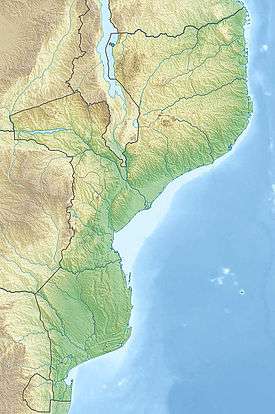Bazaruto National Park
| Bazaruto National Park | |
|---|---|
|
IUCN category II (national park) | |
|
Satellite view of the park | |
 Location in Mozambique | |
| Location | Mozambique |
| Coordinates | 21°39′57″S 35°27′57″E / 21.665724°S 35.465927°ECoordinates: 21°39′57″S 35°27′57″E / 21.665724°S 35.465927°E |
| Area | 1,430 square kilometres (550 sq mi) |
| Established | May 25, 1971 |
The Bazaruto National Park (BANP) is a protected area in the Inhambane Province of Mozambique on the Bazaruto Archipelago. The park was proclaimed on 25 May 1971. It is off the coast of the Vilanculos and Inhassoro districts, covering a large expanse of ocean and six islands.[1]
Location
The Bazaruto National Park was inaugurated in 1971, an archipelago of six islands off the Mozambican coast between Vilankulo and Inhassoro.[2] The park was created to protect dugong and marine turtles, and their habitats. The islands' flora and fauna, coral reefs and marine birds were also included.[1] The largest island is Bazaruto Island and the others are Benguerra, Margaruque, Santa Carolina (Paradise Island), Banque and Pansy Shell Island.[2]
Ecology
The islands have a lush tropical climate and include huge dunes, forest and savannah, inland lakes and wetlands.[3] They host several endemic terrestrial gastropods and lizards. They also host important aggregations of Palaearctic migrant water birds.[4] The archipelago is attractive to tourists who are interested in diving or snorkelling. The rich variety of marine life includes humpback whales, marine turtles, spinner, humpback and bottlenose dolphins, marlins and barracudas.[2] BANP gives protection to the largest and only remaining viable population of dugongs in the Western Indian Ocean.[4] The coral reefs are varied and said to be the least disturbed in this part of the Indian Ocean.[3]
People
.jpg)
The archipelago has about 3,500 resident in seven communities. They are mostly very poor and rely on harvesting natural resources to survive. 70% of households rely on small scale fishing to survive, while others harvest sand oysters and other marine resources, grow crops and raise livestock. Resources may not be sufficient to maintain the population, leading to decreased catches of fish, reduced harvests and increasing poverty and food insecurity.[4]
Conservation and Tourism
The BANP is a popular tourist destination. As of 2011 the park had five hotels promoting high-value, low-impact programs. The hotels make an important contribution to the local economy through employment and tax revenues. The World Wide Fund for Nature (WWF) has a program to help the local communities to become more sophisticated in realizing a share of revenues in return for protecting the valuable ecological resources.[4]
References
- 1 2 "The Bazaruto National Park". Mozambique Ministry of Tourism. Archived from the original on 2008-11-21. Retrieved 2011-10-16.
- 1 2 3 "Bazaruto National Park". Go2Africa Pty (Ltd). Retrieved 2011-10-16.
- 1 2 "Mozambique Travel Guide to Bazaruto Archipelago". Sitabona. Retrieved 2011-10-16.
- 1 2 3 4 "Community conservation in Bazaruto Archipelago National Park, Mozambique". WWF. Retrieved 2011-10-16.
